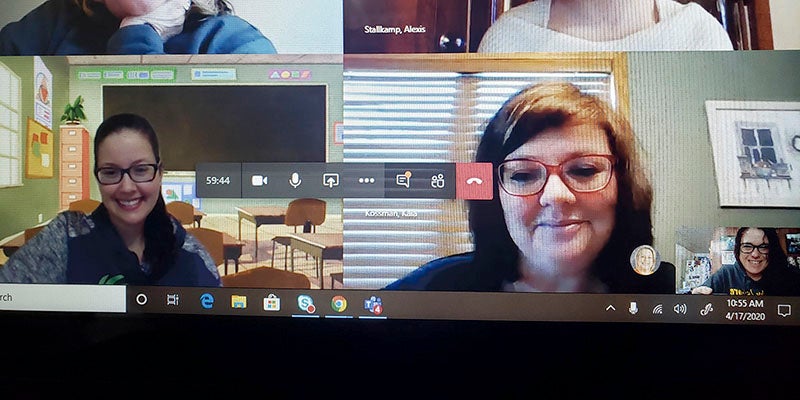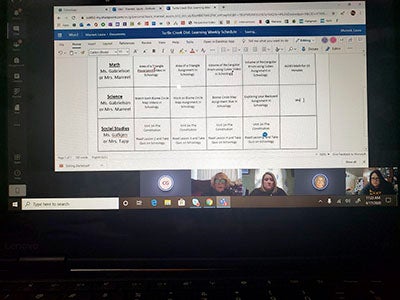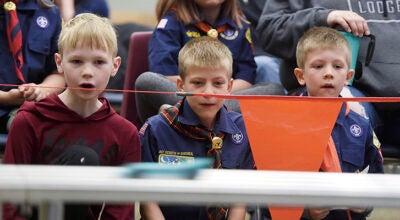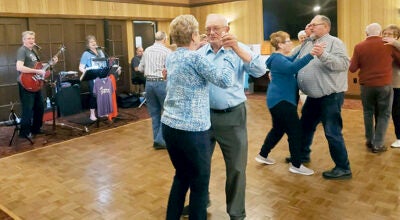A new way of teaching
Published 7:01 am Saturday, April 18, 2020

- Education has gone online because of the COVID-19 pandemic, forcing teachers to plan and teach through computers. Photo provided
|
Getting your Trinity Audio player ready...
|
Educators are embracing teaching through the medium of online
As the COVID-19 virus weight began to be felt in the state, Minnesota residents had to start adapting to a new way of life.
The phrase “the new normal” was heard often and began to have a particularly real meaning as businesses and events began shutting down.
By March, it became quickly apparent that lives were going to be turned upside down. Among those were those working in education, who suddenly and in a short amount of time had to figure out a new method of teaching that ensured that even while stuck at home, students were still getting their education.
Plans for distance learning were formulated throughout Minnesota complete with its own set of challenges: how do you get materials to students, how do you plan for those materials and how do you ensure that students are sticking to the plan?
But in the face of these challenges, educators have met them moving forward, more often than not through the unknown.
“Better than expected,” said Banfield Elementary Principal Jeff Roland from his office on Wednesday in a largely empty school. “It’s such a huge departure from (the teacher’s) class routine. There were some initial snags but we hit the ground running.”
That’s not to say that Roland isn’t willing to admit to the primary challenge of just how unfamiliar this all is.
“It’s daunting from the lack of experience,” Roland said. “I think these are uncharted waters. It’s the reality of where we are living and we’re doing the best thing we can do.”
Short turnaround
COVID-19 certainly wasn’t a surprise. In January, China announced the first cases of the novel coronavirus stemming from the Wuhan province.
The virus spread quickly from there and by Jan. 20, the United States reported its first case in the state of Washington. From there the cases in the United States grew exponentially, coming to Minnesota on March 6 in Ramsey County, where the first state case was reported.
Not long after, as cases slowly crept along, Austin Public Schools announced it already had been watching the virus’ progression closely.
“If there is a message we want to give, it’s that we have stepped up the cleaning and disinfecting of our schools to prevent not only a potential spread of the coronavirus, but flu and colds as well,” said Mark Raymond, director of human resources for the district.
Then on March 15, Gov. Tim Walz announced that schools would be shut down to begin planning for the possibility of distance learning. At the time, the plan was for schools to come back in session after March 27, but by the time that date was reached it was determined that schools would be closed indefinitely. By that point there were already 35 confirmed cases in Minnesota, and on March 19, the first death from COVID-19 was reported.
“While children have proven to be less vulnerable to this virus (and) we haven’t seen significant spreading in our schools, we do anticipate that COVID-19 will have a sizable impact on our education system in the coming weeks, months and potentially the coming year,” Walz said at the time. “We cannot wait until the pandemic is in our schools to figure things out.”
This left very little time for educators to start putting plans into motion
“That was a big challenge,” said I.J. Holton Intermediate School fifth grade reading and social studies teacher Amanda Gafkjen. “That was two days before and then we weren’t coming in anymore. We were all trying to stay apart as much as we could. Teachers collaborated, but they were spread out, not next to each other.”
That short time span was needed to get lesson plans organized and distributed out to students in a packet format. Again, it was the shadow of the unknown that was making so many things difficult.
“It was a lot to do,” Gafkjen said.
Even in that short amount of planning, it’s been a challenge just keeping in contact with the students, even though teachers create specific times of availability. It made it difficult to ensure that the students were staying on top of their work.
“It’s pretty hectic,” Gafkjen said. “I think the thing I’m struggling the most with are kids who have not stayed on their schedule. We are available 8 a.m. to 3 p.m. and many of the kids aren’t even getting on until the afternoon. That’s kind of a struggle.”
Teachers are also struggling with simply not seeing the students, especially important for elementary and intermediate schools, where teachers are used to seeing the same faces throughout the year.
That contact becomes important as a way of connecting with the students they teach.
“It’s important for the teachers and students to stay connected,” Roland explained. “We’re getting back into the swing of things and (teachers) are willing to work through with a high level of professionalism.”
Gafkjen is one of those teachers in the district who can confirm that the separation from students has been hard.
“More than academics, it’s more about them personally,” she said. “Not being able to see them everyday. Some have different home lives, different experiences. It’s not being able to see them every day and ask them every day how they are doing.”
But Gafkjen said the educators she knows and work with continue to work hard to get the education materials to the kids, and that comes with a level of inspiration.
“I’m actually quite proud of IJ and my colleagues,” she said. “We have done more than we have ever been able to do. We were constantly checking in the first week or two. It was constant meetings, but we really stepped up. This is something that’s never been taught.”
The tech
The reality is, without technology, this idea of distance learning is very challenging. It’s setting up programs and routines, making sure everybody is connected and making sure that students can get the information they need through laptops, emails and programs like SeeSaw, Zoom and Schoology.
The Blooming Prairie School District has been familiar with distance learning for a while now. In 2012, the district instituted a one-to-one set-up where each student grades 7-12 was given a device to help with distance learning plans.
Erik Vigeland, technology coordinator for Blooming Prairie, said that move to go one-to-one, put the district ahead of the curve and placed them in a position to be a little more prepared for the effects of COVID-19.
That didn’t mean, however, that there wasn’t plenty to do.
“It was a ton of work. We got two weeks to prepare for it at the high school because they were ready,” Vigeland said. “The teachers already use Schoology. They push whatever they want to teach onto Schoology, but it still took a while to get up and going.”
The first week was especially challenging because it reflected struggles throughout the Minnesota and national educational systems. The reflection came with the struggles from Schoology itself.
“That first week of distance learning, when we actually jumped in, was pretty chaotic,” Vigeland said. “Schoology said they were having issues because their usage went up 400 percent. It was really chaotic. Phone calls and emails couldn’t keep up.”
The nice thing to come out of it is a staff that worked to shore up any issues and jump in to keep the process running as smoothly as possible.
“We’re awfully grateful how hard the teachers and administration has been working,” Vigeland said. “Our teachers have been rock stars. This was just thrown on them like it has been on everybody. They just jumped into it. There were questions like, ‘how can I record myself, how can I get up on Schoology …we just worked through it.”

Teachers at Austin Public Schools are collaborating online, helping with things like lesson planning. Photo provided
Specialized education
Many places that deal in specialized education had some hurdles of their own, and yet in some ways were in a little better position to take on the challenge than some places.
Kathy Piller is lead teacher of the Alternative Learning Center at the Southeast Minnesota Education Consortium, which just moved into its new school east of Austin along Interstate 90 this year.
She said that things have been running pretty smoothly at the school, with a couple hiccups here and there.
“For us it’s just getting the kids used to getting online so we could see them,” Piller said.
Like Schoology and SeeSaw, SMEC teachers use an app called Blue Jeans that allows them to work with teachers through their studies.
It’s been working, but Piller said it’s put too much distance into distance learning.
“I don’t like the fact that I can’t see the kids all day long because we’re actually family,” Piller said. “Are these kids doing well? I am also seeing a lot of my older kids have gone out and gotten almost full time jobs. We have to adjust the times with the kids to meet with them.”
However, students at SMEC have lesson plans individually tailored to them in an effort to meet the students where they are. It’s been a benefit in meeting distance learning needs.
“Our kids did things at their own pace so they were ready for this,” Piller said, though she added, “It’s hard for them to still manage their time when they are not in school. A week and a half not being in school or doing anything got them out of their routine.”
Dan Armagost is the executive director of SMEC and he’s been pleased with how both staff and teachers have met the needs of their students through all of this.
“I would say overall, we’re pleased with the way things are going,” he said. “It’s definitely not the same as if we were providing education face to face, but I’m proud of our teachers and proud of our students on how they adapted to the change.”
While one side of SMEC deals with students from an ALC standpoint, the other part of the school is providing education to students with special needs.
And even in the midst of the upheaval caused by COVID-19, these students have still been able to get both the care and the education they need.
“We have been able to continue mental health services to provide services,” said Director Denise Kennedy. “They are still getting their time with workers.”
There’s also been unprecedented cooperation across the seven school districts that make up SMEC, whether its through the spreading of ideas or in terms of long term planning.
It’s also promoted a different kind of thinking when it comes to planning.
“Our teachers are so creative,” Kennedy said. “We really encourage out of the box thinking and the longer the teachers are doing this the more creative they are getting.”
Pride
Each school has its own story to tell during all of this, but one thing that has resounded through it all has been pride.
“A big thank you to our teachers with the way they have handled it,” Armogast said. “ The online forum is new. It’s like they have to learn a new language. It’s been a whole village and everybody is stepping up in order to get through.”
As teachers, paraprofessionals and adminstration continue to work through this it would be easy to see a dip in morale, but at Banfield, Roland has seen a continued push to keep going through the process.
“We had packet distribution Monday and the teachers came in and that was a really upbeat day,” he said. “But there’s that down feeling of not being with the kids.”
Still, educators around the area have been coming together to ensure the effort to provide students with continued education doesn’t lag.
“Really, the thing for me personally is I’m really impressed by friends and colleagues who have stepped up to help,” Gafkjen said. “We’re always just there to help.”
And when it’s all said and done, those working at schools will be able to look back with that same pride at the work that was done in an extreme circumstance.
“I’m so proud of the staff at Banfield,” Roland said. “Nobody signed up for this … they’ve dug in and provided quality tools for students and parents. I couldn’t be more proud of the products going out and the level of professionalism.”




